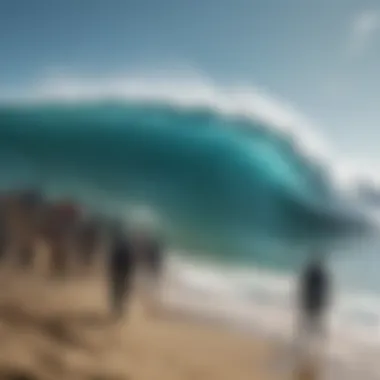Ocean Dumping: Impact on Surfing Communities


Intro
Ocean dumping has become a buzzword in the discussions surrounding environmental conservation, especially for those who live and breathe the surf life. The practice involves discharging waste materials into the ocean, often disregarding its harmful impact on marine ecosystems. For surfing communities, this presents a myriad of challenges, given that clean and healthy oceans are essential for both the enjoyment of surfing and the overall vitality of coastal environments.
The implications of ocean dumping go far beyond the immediate visual pollution we can sometimes see on the shore. Just think about it: every time someone surfs a wave, they interact with the water, and if that water is tainted, surfers are risking their health and the health of marine life. Surfers need to be well-informed about these threats, as well as potential regulations and alternative waste-disposal methods that can mitigate these issues.
Understanding the implications and realities of ocean dumping is critical not just for safeguarding your surfing experience but also for nurturing a culture that values sustainability and environmental consciousness. Recognizing the interconnectedness of our actions and the health of our oceans can empower surf communities to advocate for cleaner practices.
This article will shed light on the vital aspects of this issue, from how ocean dumping affects our beloved surf spots to practical solutions for both surfers and coastal residents alike.
Understanding Ocean Dumping
Ocean dumping is not just a term tossed around in environmental discussions; it’s a pivotal issue that intertwines with the very fabric of coastal living, particularly for surfing communities. By grasping the nuances of ocean dumping, we start to see the broader implications it has, not only on the waves we ride but also on our health, economy, and ecosystem.
Definition and Scope
Ocean dumping refers to the process of disposing waste into the ocean. Now, this encompasses a wide range of materials, from everyday trash to hazardous substances. The scope of this practice is vast and complex, often leading to ecological imbalances and posing threats to marine life. Understanding this definition is crucial as it lays the groundwork for realizing how our beautiful surf spots could be at risk from contaminants and pollution.
Types of Materials Dumped
Various materials find their way into the ocean, and categorizing these is vital for comprehending their specific impacts. Each type of waste carries its own set of consequences, particularly for surfing communities that thrive on clean beaches and healthy waters. Here are some key categories:
Solid Waste
Solid waste is the stubborn debris we see washed up on the shore – think plastics, abandoned fishing gear, and food wrappers. It represents a significant portion of dumped materials, often contributing to the eyesore that many surfing locales can become. Besides its unsightly nature, solid waste has a knack for disrupting marine ecosystems. Fish and other wildlife may mistake bits of plastic for food, leading to disastrous consequences for their health and, indirectly, our own. Moreover, as surfers, we might find ourselves riding waves that have more than just water in them.
Liquid Waste
Liquid waste brings another layer of complexity to ocean dumping. This category includes anything from industrial runoff to sewage and even chemicals dumped offshore. The key characteristic of liquid waste is its ability to disperse quickly, but that doesn't mean it’s harmless. These contaminants can lead to harmful algal blooms or dead zones – areas in the water devoid of life due to oxygen depletion. For surfers, this translates to not just potential sickness but also the degradation of surf conditions over time.
Hazardous Materials
Now, let’s talk about hazardous materials. These are no joke. They might include heavy metals, toxic chemicals, and other harmful substances that can have a lasting impact on marine life and human health. The thing about hazardous materials is their ability to bioaccumulate; this means that toxic substances can build up in the tissues of living organisms. As waves crash on the shore, surfers might unknowingly expose themselves to these dangers, which could range from skin irritations to more severe health issues.
When we look at ocean dumping through these lenses, we start to understand not just the environmental ramifications but also the threats to our surfing culture and overall coastal community well-being. The implications reach far beyond the surface, impacting everything from the economy to the ecological health of our oceans.
"To protect our oceans is to ensure the future of surfing itself; we're the guardians of the waves we ride."
By bringing light to these issues, we encourage a dialogue that fosters awareness and, ultimately, action among surfers and coastal inhabitants alike. Recognizing what goes into our oceans is the first step toward safeguarding our beloved waves and the vibrant life that resides beneath them.
Historical Context of Ocean Dumping
Understanding the historical context of ocean dumping is crucial for grasping its long-lasting effects on surfing communities and marine ecosystems. This history sheds light on how dumping practices evolved, and why such activities became prevalent. It also reflects our growing awareness of environmental issues and the subsequent demand for actionable regulations aimed at protecting our oceans.
Evolution of Practices
From as early as the 19th century, humans began to view the ocean as a convenient dumping ground. Ships often discarded waste directly into the water, believing the vastness of the ocean would handle it without consequence. Early practices included the disposal of food scraps, human waste, and even industrial byproducts. As urbanization progressed and industrial activities surged, the nature of waste shifted to more hazardous materials.
In the 1950s and 1960s, with advancements in chemical production and plastic manufacturing, oceans worldwide saw a significant increase in dumping. Cities, unable to effectively treat their rising waste, shifted the burden to the sea. For instance, in Southern California, numerous landfills were closed, leading to increased ocean dumping of construction debris and municipal waste.
The rise of recreational activities, including surfing, began to clash with these practices. As surfers started noticing environmental degradation, calls for change arose. The 1970s marked a turning point, with the establishment of environmental protection entities. Society began questioning the sustainability of treating the ocean as a waste receptacle. Thus, awareness grew, underscoring the urgent need for responsibility in how we handle waste.
Key Milestones in Regulation
The regulation of ocean dumping reflects both domestic and international efforts to take a stand against pollution. In the United States, the Marine Protection, Research, and Sanctuaries Act, passed in 1972, represented a pivotal moment in protecting marine environments. This act prohibited the dumping of radioactive or hazardous waste without a comprehensive permitting process.
On a global scale, the London Convention of 1972 aimed to reduce pollution from dumping waste at sea. It fostered cooperation among nations, creating guidelines to ensure that dumping activities did not harm marine ecosystems. Over the years, amendments and agreements, such as the 1996 London Protocol, strengthened these regulations, highlighting the need to substitute ocean dumping with more sustainable waste disposal methods.
This evolving landscape underscores that ocean dumping is not just an environmental issue but also one that intertwines with public health, economic stability, and the cultural practices of communities that thrive on the ocean.
Regulatory Framework
Understanding the regulatory framework surrounding ocean dumping is crucial for surfers and surfing communities. It serves as a bulwark against the escalating pollution of the seas, safeguarding not just marine ecosystems but also the very waves surfers ride. Ineffective regulations could lead to unchecked waste disposal, resulting in dire consequences for both human and marine health. This section discusses the various levels of governance that govern ocean dumping, highlighting international treaties and national laws designed to mitigate this environmental crisis.


International Treaties and Agreements
The London Convention
The London Convention, formally known as the Convention on the Prevention of Marine Pollution by Dumping of Wastes and Other Matter, established in 1972, plays a significant role in regulating the disposal of waste into the ocean. This treaty seeks to prevent marine pollution while considering the environmental and maritime industry health. It emphasizes a precautionary approach, mandating that only those substances deemed safe may be dumped. One of its key features is that it operates under an overarching principle that all dumping must be minimized, if not outright eliminated.
The London Convention is particularly beneficial for surfing communities, as it creates a framework that prioritizes marine health, essential for maintaining good surf conditions. However, despite its positive impact, there are criticisms regarding its enforcement; member countries sometimes fail to adhere strictly to the regulations, leaving loopholes for continued harmful dumping.
MARPOL Protocol
The MARPOL Protocol, or the International Convention for the Prevention of Pollution from Ships, is another cornerstone in the fight against ocean dumping. It specifically targets ship-related pollution, addressing issues like oil spills, sewage discharge, and hazardous waste. Its advantage lies in its broad reach; it encompasses various sources of marine pollution beyond traditional waste dumping.
From a surfing perspective, MARPOL ensures that the oceans remain as clean as possible, which, in turn, protects the health of surfers and the quality of the waves. However, there's a caveat. While its comprehensive scope is impressive, the challenge lies in the varying levels of commitment from different countries regarding compliance with the regulations.
National Regulations
EPA Guidelines
Nationally, the Environmental Protection Agency (EPA) in the U.S. has put forth guidelines that dictate how ocean dumping should be handled. These guidelines are tailored to protect marine life and public health while promoting sustainable practices among coastal communities. The EPA's emphasis on thorough assessments before granting permits for ocean dumping is one of the hallmarks of these regulations. They also encourage monitoring and research to continuously evaluate the health of marine ecosystems.
This is a beneficial choice for this article as it directly relates to how surfing communities can advocate for cleaner oceans by supporting these guidelines. However, many argue that without stricter enforcement, these guidelines can sometimes fall short, allowing pollution to slip through the cracks.
State-Specific Laws
On the state level, regulations can vary widely, reflecting local priorities and environmental concerns. State-specific laws can address unique regional issues that may impact surfers more directly, such as protecting local surf breaks from industrial runoff or ensuring water quality testing around popular beaches. These laws often serve as a good complement to federal guidelines, creating a more localized and vigilant approach to the problem.
However, the downside to state-specific regulations is that inconsistency can create confusion within surfing communities. Moreover, some states may lack the resources needed to enforce their regulations effectively, leading to discrepancies in pollution control efforts.
In summary, navigating the regulatory landscape of ocean dumping is paramount for surfing communities. While international treaties like the London Convention and MARPOL Protocol offer frameworks for protecting the oceans, national and state regulations are equally essential in making sure those frameworks are upheld and adapted to local needs. Understanding these layers enables surfers to become advocates for change, promoting a culture of sustainability in their beloved sport.
Environmental Impact of Ocean Dumping
Understanding the impact of ocean dumping is vital, especially for communities that thrive on coastal resources, like surfers. Ocean dumping doesn’t happen in a vacuum; it creates ripples in marine ecosystems, affecting not just the water but also the organisms that call it home. The consequences can be far-reaching, impacting everything from fish populations to swimmers at the beach. By grappling with these implications, surfing communities are better prepared to advocate for changes that safeguard their environment.
Effects on Marine Biodiversity
Marine biodiversity is the backbone of healthy ocean ecosystems. When waste, particularly organic and non-biodegradable materials, is dumped into the sea, it disturbs this delicate balance. Certain species may suffer from habitat loss, while others can thrive unchecked due to changes in competition. For example, invasive species can flourish in nutrient-rich environments created by improperly managed organic waste. This shift often leads to the decline of native species – a concern not just for marine life but also for surfers who depend on diverse ocean habitats for enjoyable and safe conditions.
Pollution and Its Consequences
Pollution from ocean dumping doesn't just disappear; it accumulates and creates serious health risks for marine life and humans alike. Two of the most insidious types of pollutants are microplastics and chemical contaminants.
Microplastics
Microplastics bemome a significant concern due to their minute size, which allows them to infiltrate ecosystems more than larger debris. They arise from the breakdown of larger plastic objects or are intentionally produced small particles. The key characteristic here is their persistence – once in the water, they don't degrade easily.
Some key point about microplastics:
- They can attract toxins that harmful chemicals can bind to before entering the food chain.
- Marine life, from small fish to filter-feeding organisms, consume these particles mistaking them for food.
The unique feature of microplastics, their pervasive presence, presents notable disadvantages. Surfers may be unwittingly exposing themselves to these harmful particles each time they hit the waves. It creates a two-fold tragedy; not only do surfers face potential health impacts, but the marine life they cherish also suffers.
Chemical Contaminants
Chemical contaminants are an equally pressing concern. Commonly found in industrial waste, such substances like heavy metals and pesticides can severely affect marine and coastal ecosystems. The unique feature of these contaminants lies in how they bioaccumulate, meaning they build up in organisms over time, leading to increasing toxicity.
- The key characteristic of chemical contaminants is their ability to disrupt hormone systems and other physiological processes.
- This issue leads to abnormally-sized or malformed species and can decimate fish populations crucial for beach economies and surfing.
The implications are profound; surfers may face health issues, and the cultures surrounding surf depend on a clean, healthy ocean. Thus, diving into the impact of ocean dumping allows communities to forge a more sustainable future.
Impacts on Coastal Communities
The impacts of ocean dumping resonate deeply with coastal communities, fundamentally reshaping their environmental landscape, public well-being, and the economic fabric that supports local surf cultures. Understanding these implications is paramount for surfers, beachgoers, and residents alike, providing insight into how their beloved shoreline is affected by activities far offshore.


Public Health Concerns
Public health is one of the most pressing concerns linked to ocean dumping. When waste is discarded into coastal waters, it doesn't just vanish; it often introduces hazardous substances into the marine environment. These pollutants can find their way into seafood, as fish and shellfish absorb toxins like heavy metals and chemicals. For those who enjoy catching and consuming their own seafood, this is a particularly alarming risk.
In addition, the very presence of contaminants in the water can lead to serious health issues. Swimming in polluted waters exposes beachgoers and surfers to a range of health threats, including gastrointestinal infections, skin rashes, and even severe illnesses stemming from harmful bacteria and viruses. Regular testing and public advisories are crucial in surf communities, urging caution especially after heavy rains or known dumping incidents.
Key aspects to consider:
- Increased Infection Rates: Surfers, accustomed to spending hours in the water, are notably at risk.
- Health Education Programs: Public awareness campaigns can help inform the community about safe practices.
- Long-Term Health Effects: Some pollutants accumulate over time, leading to chronic health issues.
"Staying informed about water quality isn’t just advisable; it’s essential for anyone who interacts with our oceans."
Economic Implications for Surfing Culture
The economic implications of ocean dumping on surfing culture are multifaceted and substantial. Coastal regions thrive on tourism, particularly surf tourism, which attracts enthusiasts from around the globe. However, when ocean dumping leads to polluted waters or dirty shores, negative perceptions can thrive, driving visitors away. Surfers and businesses alike suffer when beaches are deemed unsafe, resulting in a decline of foot traffic.
Moreover, local economies that depend on thriving water sports often face increased cleanup costs and lost income during periods of restricted beach access. Business owners, from surf shops to rental enterprises, can experience a sharp drop in revenue, directly affecting livelihoods.
Consider the following economic impacts:
- Decline in Tourism: Reduced visitor numbers can lead to annual revenue drops for local businesses.
- Increased Cleanup Costs: Local governments may redirect funds to mitigate the effects of dumping.
- Job Losses: Smaller operators might struggle to stay afloat, leading to layoffs.
In summary, understanding the impacts of ocean dumping on coastal communities is not merely an academic endeavor; it is a vital call to action for surfers and coastal inhabitants. By recognizing these challenges, stakeholders can better advocate for cleaner oceans, ensuring the sustainability of their beloved surf culture and the health of their communities.
Case Studies
Case studies serve as critical touchstones in the examination of ocean dumping and its implications for surfing communities. By investigating specific incidents, we can glean insights into the direct effects on marine environments and coastal cultures. These real-world examples allow surfers, environmental activists, and policymakers to parse the complexities of ocean dumping, generating discussions about prevention, remediation, and management strategies. They highlight not only the issues at hand but also provide a narrative of community resilience and response, informing future action plans.
Notable Incidents of Ocean Dumping
The noteworthiness of case studies about ocean dumping lies in the tangible realities they expose. We can comprehend the gravity of pollution through examination of both local and global incidents, turning abstract issues into vivid experiences. Through these examples, one's understanding grows deeper, fostering a dialogue that transcends geographical boundaries.
Local Examples
Local incidents of ocean dumping often draw attention to specific areas where surfing cultures intersect with environmental challenges. A prime illustration can be found in the case of California's coastal waters, where instances of illegal dumping of construction debris have raised significant alarm among local surfers.
The key characteristic of this case is its proximity to surf-friendly beaches like Huntington Beach. This choice is relevant because it showcases how the actions of a few can have a sprawling impact on the surf culture that thrives there. Unwanted materials can result not only in unsightly views but also in compromised safety, as submerged debris poses hazards to surfers—a disconcerting reality for those seeking thrills on the waves.
The unique feature of local examples is that they allow community members to take swift action. Local surf organizations have banded together for beach clean-ups and heightened awareness campaigns, effectively turning local incidents into opportunities for positive action. However, the disadvantages include a sometimes limited scope, as localized efforts may not lead to broader systemic changes.
Global Cases
On a grander scale, global cases of ocean dumping illustrate the universal nature of pollution issues affecting surf communities worldwide. A notable example is the illegal dumping in the Mediterranean Sea, which has chronicled extensive amounts of plastic waste entering the ecosystem, affecting marine life and beach goers alike.
The key characteristic of global cases like this is their capacity to mobilize international concern. The Mediterranean provides a shared resource for numerous nations and an incredible surfing destination. Observing trends of pollution here highlights the interconnectedness of our oceans, reinforcing the importance of collaborative efforts among surfing communities worldwide.
A unique feature of global cases is their potential for instigating policy change at an international level. Such situations can lead to treaties and protocols aimed at mitigating further damage. However, the downside here is the slow pace of real change, often hampered by conflicting national interests and lack of immediate accountability.
Overall, both local and global case studies are indispensable elements in understanding the implications of ocean dumping on surfing communities. They present both a mirror and a roadmap for what needs to be addressed.
Public Perception and Awareness
Awareness around ocean dumping is steadily gaining importance within surfing communities and beyond. How people perceive the issue shapes both local activism and broader legislative actions. When surfers and coastal residents voice their concerns, they bring more attention to the environmental degradation caused by dumping. Ignoring this topic can have severe repercussions for both marine life and surf culture.
Here’s why public awareness is crucial:
- Informed Advocacy: With rising education and awareness, surfers can advocate more effectively for cleaner beaches and oceans. When individuals understand that ocean dumping is not just a distant problem, but one that affects their local surf spots, they are far more likely to engage in initiatives that deal with it.
- Community Solidarity: As more surfers participate in environmental campaigns, they build a network of shared passion. The bond fostered through collective efforts can lead to sustained activism and community resilience against environmental neglect.
- Pressure on Authorities: Public awareness can create waves of accountability for governments and corporations responsible for the waste dumped in oceans. Citizens demanding transparency and stricter regulations can push for policies that protect marine ecosystems.
"Communities that join together for a cause can make impressive changes. Alone, one voice may struggle to be heard, but together we form a chorus that demands action."
Surfer Perspectives on Environmental Issues
Surfers often have a unique connection to the ocean, viewing it as both a playground and a home for diverse marine species. Their perspectives on environmental issues are not just personal; they are deeply rooted in their lifestyle. Many surfers inherently feel a responsibility toward the protection of the ocean, primarily because they benefit from it directly.


Surfers see the effects of dumping firsthand. Discolored water, coastal debris, and the decline of local marine life are not abstract concepts; they are realities that affect their daily experiences. This leads to several scenarios in which surfers engage with environmental issues:
- Increased Participation in Cleanups: Many local surf shops host beach clean-up events, rallying surfers to contribute actively. These efforts extend their love for the sport into a commitment to protect ocean health.
- Initiation of Environmental Campaigns: Some surfers leverage their influence to raise awareness. By using social media platforms and writing articles, they help spread the word on harmful practices such as ocean dumping.
- Educational Engagement: Recognizing that awareness begins with knowledge, surfers often share insights about the environmental impact of pollutants on aquatic ecosystems with newcomers.
The Role of Activism
Activism plays a pivotal role in shaping the conversation around ocean dumping. It acts as a catalyst for change, providing a platform for surfers and advocates alike to unite against pollution. In many coastal communities, surfers often evolve into activists leading the charge for environmental consciousness.
Several key aspects highlight how activism intersects with ocean dumping issues:
- Community Grassroots Movements: These movements often stem from passionate surfers who organize campaigns and rallies to call attention to ocean dumping and related issues. The success of these grassroots initiatives relies heavily on community involvement.
- Partnerships for Impact: Collaborations form between surf organizations, environmental NGOs, and local governments to devise sustainable solutions. Marketed as partnerships for cleaner oceans, these alliances help enhance public awareness, leading to more effective environmental stewardship.
- Policy Advocacy: Dedicated activists work to lobby for stronger regulations on waste management and ocean biospheres. By presenting research, testing alternatives, and engaging with lawmakers, they lay the foundation for policies that prioritize the health of marine ecosystems.
In summary, public perception and awareness about ocean dumping offer critical insights into a pressing issue that not only threatens marine life but also jeopardizes the very heartbeat of surf culture. Surfers, through their unique perspectives and activist roles, embody a significant force for change, advocating for a healthier relationship between humans and the ocean.
Innovative Solutions to Combat Ocean Dumping
Ocean dumping presents a myriad of challenges for surfing communities, and thus the search for innovative solutions is crucial. These strategies not only aim to preserve the ocean, which surfers hold dear, but they also prioritize marine health and safety. By leveraging advanced technology and fostering community involvement, these initiatives can make a significant impact in reducing ocean dumping.
Technological Advances
Monitoring Systems
Monitoring systems are pivotal for addressing the issue of ocean dumping. They play a role in detecting and tracking dumping activities, enhancing accountability. One key characteristic of these systems is their ability to collect real-time data regarding waste disposal patterns. This is a beneficial choice for our article as it helps coastal communities identify problematic areas prone to illegal dumping.
A unique feature of monitoring systems is their use of satellite imagery combined with artificial intelligence to analyze vast ocean expanses. This technology has distinct advantages. Not only does it provide an efficient way to monitor the environmental health of oceans, but it also allows for quicker responses to potential threats. However, the implementation of these systems can be costly, posing a challenge for budget-constrained coastal communities.
Waste Treatment Innovations
Waste treatment innovations represent another proactive approach to combating ocean dumping. These technologies focus on preventing waste from entering the ocean in the first place. A key characteristic of waste treatment innovations is their versatility, often capable of processing various types of waste, including plastics and hazardous materials. This is a popular method addressed in this article due to its effectiveness in reducing the overall waste burden on ocean ecosystems.
One unique feature is the emergence of mobile waste treatment units that can be deployed in remote areas or during large events, such as surfing competitions. The advantages of these units are clear: they provide immediate waste management solutions and help minimize the risk of dumping during high-traffic periods. Conversely, a potential disadvantage lies in the reliance on local infrastructure to support these mobile systems, which may not always be available in every coastal region.
Community Initiatives
Engaging local communities is essential in the fight against ocean dumping. This section highlights initiatives that empower surfers, beachgoers, and residents to take action.
Beach Cleanups
Beach cleanups are a grassroots response which plays an essential role in combating ocean dumping. These events not only improve the aesthetics of coastlines but also serve to reduce the existent trash that threatens marine life. The key characteristic of beach cleanups is that they foster community spirit while educating participants about ocean conservation.
A unique feature is the increasing collaboration between businesses, schools, and non-profits in organizing these events. The benefits of beach cleanups are numerous: they enhance local habitats, raise awareness about pollution, and encourage positive connections within the community. However, ensuring ongoing participation can be a challenge, as people may lose interest over time without sustained engagement.
Educational Programs
Educational programs are invaluable tools for promoting awareness around ocean dumping and its effects on coastal environments. Their specific aspect lies in providing knowledge to local surfers and community members about how everyday actions can impact the ocean. One key characteristic of educational programs is their focus on sustainable practices, which can encourage behavioral changes.
These programs often include workshops, school presentations, and informational materials. A unique feature is their adaptability; they can be tailored to various age groups and interests, making the information accessible to a wide audience. The advantages of these programs include fostering a culture of responsibility and stewardship towards the ocean. Nevertheless, one challenge is that not all community members may have equal access to these programs, leading to gaps in knowledge and understanding.
Ultimately, successful solutions to ocean dumping hinge on combined technology and community involvement, leading to cleaner oceans and healthier surf conditions.
Future Prospects and Sustainable Practices
As the impacts of ocean dumping become more prevalent, the need for thoughtful and proactive approaches to sustainability has never been greater. By engaging with sustainable practices, surfing communities can actively contribute to the well-being of marine ecosystems while ensuring that the sport they love endures for years to come. This section will explore the role surfers can play in advocacy and how integrative sustainable practices can be woven into the fabric of the surfing lifestyle.
The Role of Surfers in Advocacy
Surfers are often viewed as guardians of the ocean. Their unique connection to the sea places them in a pivotal position to influence change. Surfing communities can advocate for cleaner oceans through several avenues:
- Community Awareness: By raising awareness about ocean dumping and its detrimental effects, surfers can create ripples of change. Sharing knowledge through social media platforms like Facebook and Reddit amplifies the message, reaching a wider audience.
- Partnerships with NGOs: Collaborating with local organizations focused on ocean conservation can lead to impactful joint initiatives. Through these partnerships, surfers can help organize beach clean-ups and conservation programs that directly address the issue of ocean dumping.
- Legislative Involvement: By actively participating in public forums and advocating for stricter regulations against ocean dumping, surfers can lend their voices to the decision-making process. Their first-hand experiences and knowledge of the ocean can help policymakers understand the profound importance of protecting marine ecosystems.
"Surfers are not just riders of the waves; they are the voice of the ocean, pushing for change in ways that resonate with local cultures and the broader global community."
Integrating Sustainable Practices in Surfing
Embracing sustainability isn't just about advocacy; it's about embedding environmentally conscious practices into everyday surfing culture. Here are several strategies that can be adopted:
- Use of Eco-friendly Gear: Opting for surfboards made from sustainable materials can significantly reduce environmental impact. Companies are now producing boards from recycled polystyrene or natural resins, prioritizing both performance and eco-friendliness.
- Sustainable Travel: When surfers travel to catch the perfect wave, they should consider their carbon footprint. Carpooling, using public transportation, or organizing group transport can minimize emissions.
- Conscious Consumption: Choosing to support local surf shops that prioritize sustainability helps in maintaining a healthy economy while fostering community ties. This sustains the local surfing culture while minimizing ecological degradation.
- Education and Workshops: Surf schools and instructors can play a crucial role by incorporating sustainability best practices into their training programs. Educating new surfers about the environment and the importance of protecting it ensures the next generation values and cares for the ocean properly.
By implementing these measures, surfers not only enhance their own experience but also protect the ocean for future generations. The surf culture, deeply intertwined with the health of our coasts, can thrive as long as we remain committed to acknowledging our responsibilities and acting upon them.















